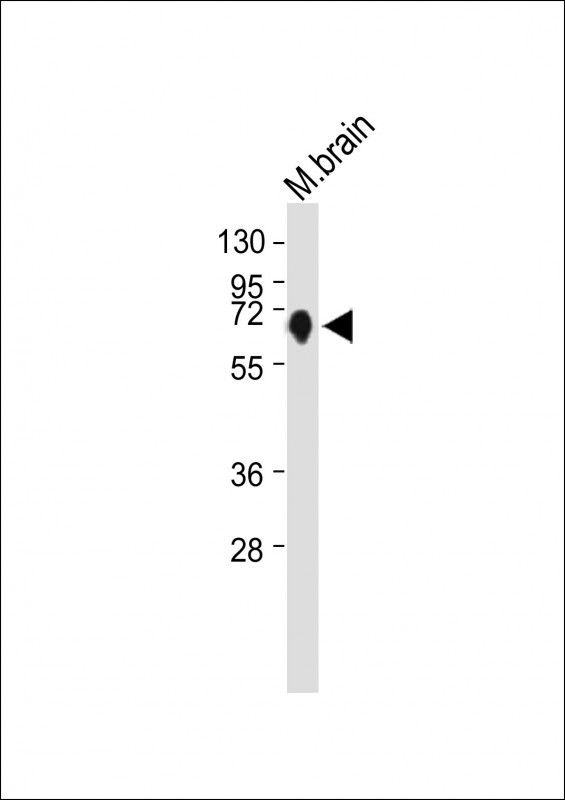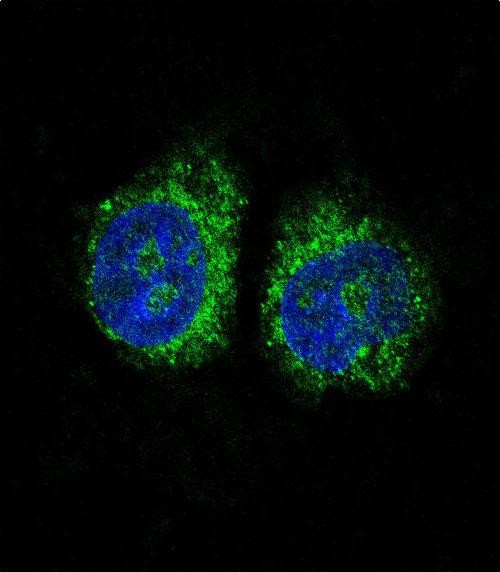NURR1 (NR4A2) Antibody (N-term)
Purified Rabbit Polyclonal Antibody (Pab)
- 产品详情
- 文献引用 : 1
- 实验流程
- 背景知识
Application
| WB, IHC-P, IF, E |
|---|---|
| Primary Accession | P43354 |
| Other Accession | Q07917, Q06219, Q08E53 |
| Reactivity | Human, Mouse, Rat |
| Predicted | Rat, Bovine |
| Host | Rabbit |
| Clonality | Polyclonal |
| Isotype | Rabbit IgG |
| Calculated MW | 66591 Da |
| Antigen Region | 13-42 aa |
| Gene ID | 4929 |
|---|---|
| Other Names | Nuclear receptor subfamily 4 group A member 2, Immediate-early response protein NOT, Orphan nuclear receptor NURR1, Transcriptionally-inducible nuclear receptor, NR4A2, NOT, NURR1, TINUR |
| Target/Specificity | This NURR1 (NR4A2) antibody is generated from rabbits immunized with a KLH conjugated synthetic peptide between 13-42 amino acids from the N-terminal region of human NURR1 (NR4A2). |
| Dilution | WB~~1:1000 IHC-P~~1:100~500 IF~~1:10~50 E~~Use at an assay dependent concentration. |
| Format | Purified polyclonal antibody supplied in PBS with 0.09% (W/V) sodium azide. This antibody is prepared by Saturated Ammonium Sulfate (SAS) precipitation followed by dialysis against PBS. |
| Storage | Maintain refrigerated at 2-8°C for up to 2 weeks. For long term storage store at -20°C in small aliquots to prevent freeze-thaw cycles. |
| Precautions | NURR1 (NR4A2) Antibody (N-term) is for research use only and not for use in diagnostic or therapeutic procedures. |
| Name | NR4A2 |
|---|---|
| Synonyms | NOT, NURR1, TINUR |
| Function | Transcriptional regulator which is important for the differentiation and maintenance of meso-diencephalic dopaminergic (mdDA) neurons during development (PubMed:15716272, PubMed:17184956). It is crucial for expression of a set of genes such as SLC6A3, SLC18A2, TH and DRD2 which are essential for development of mdDA neurons (By similarity). |
| Cellular Location | Cytoplasm. Nucleus. Note=Mostly nuclear; oxidative stress promotes cytoplasmic localization |
| Tissue Location | Expressed in a number of cell lines of T-cell, B- cell and fibroblast origin. Strong expression in brain tissue |
For Research Use Only. Not For Use In Diagnostic Procedures.

Provided below are standard protocols that you may find useful for product applications.
BACKGROUND
Parkinson's disease (PD) is a multifactorial disease that appears to arise from the effects of both genetic and environmental influences. The known genetic factors include multiple genes that have been identified in related parkinsonian syndromes, as well as alpha-synuclein. Genes associated with either PD or Parkinson-related disorders include parkin, DJ-1, ubiquitin C-terminal hydrolase isozyme L1 (UCH-L1), nuclear receptor-related factor 1 (NURR1), and alpha-synuclein. Nurr1 is a transcription factor that is expressed in the embryonic ventral midbrain and is critical for the development of dopamine (DA) neurons. It belongs to the conserved family of nuclear receptors but lacks an identified ligand and is therefore referred to as an orphan receptor. RXR ligands can promote the survival of DA neurons via a process that depends on Nurr1-RXR heterodimers. In developing DA cells, Nurr1 is required for the expression of several genes important for DA synthesis and function. Nurr1 is also important for the maintenance of adult DA neurons.
REFERENCES
Perlmann T, et al. Cell Tissue Res. 318(1):45-52 (2004) Hsu HC,et al. Curr Drug Targets Inflamm Allergy. 3(4):413-23 (2004) Wallen-Mackenzie A, et al. Genes Dev. 17(24):3036-47 (2003) Ichinose,H., et al. Gene 230 (2), 233-239 (1999) Okabe,T., et al. J. Immunol. 154 (8), 3871-3879 (1995) Mages,H.W., et al. Mol. Endocrinol. 8 (11), 1583-1591 (1994)
终于等到您。ABCEPTA(百远生物)抗体产品。
点击下方“我要评价 ”按钮提交您的反馈信息,您的反馈和评价是我们最宝贵的财富之一,
我们将在1-3个工作日内处理您的反馈信息。
如有疑问,联系:0512-88856768 tech-china@abcepta.com.






















 癌症的基本特征包括细胞增殖、血管生成、迁移、凋亡逃避机制和细胞永生等。找到癌症发生过程中这些通路的关键标记物和对应的抗体用于检测至关重要。
癌症的基本特征包括细胞增殖、血管生成、迁移、凋亡逃避机制和细胞永生等。找到癌症发生过程中这些通路的关键标记物和对应的抗体用于检测至关重要。 为您推荐一个泛素化位点预测神器——泛素化分析工具,可以为您的蛋白的泛素化位点作出预测和评分。
为您推荐一个泛素化位点预测神器——泛素化分析工具,可以为您的蛋白的泛素化位点作出预测和评分。 细胞自噬受体图形绘图工具为你的蛋白的细胞受体结合位点作出预测和评分,识别结合到自噬通路中的蛋白是非常重要的,便于让我们理解自噬在正常生理、病理过程中的作用,如发育、细胞分化、神经退化性疾病、压力条件下、感染和癌症。
细胞自噬受体图形绘图工具为你的蛋白的细胞受体结合位点作出预测和评分,识别结合到自噬通路中的蛋白是非常重要的,便于让我们理解自噬在正常生理、病理过程中的作用,如发育、细胞分化、神经退化性疾病、压力条件下、感染和癌症。










